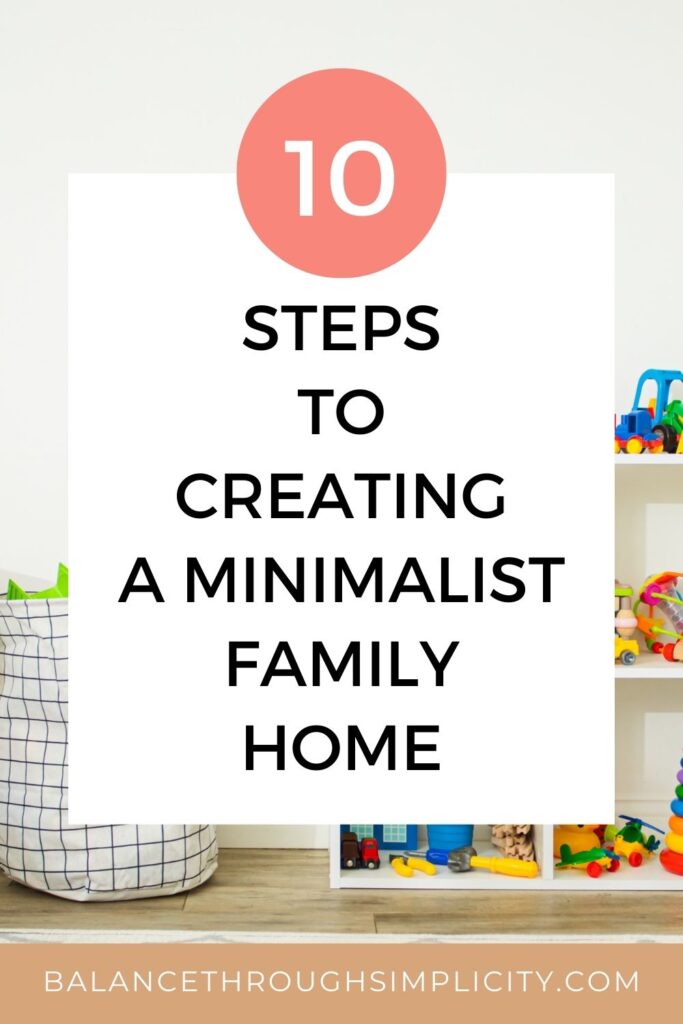10 STEPS TO CREATING A MINIMALIST FAMILY HOME THAT WORKS FOR YOU
Home is where the heart is and for many it’s the hub of family life. Create a home that works well for you and your family and that’s also easier to keep clean, tidy and clutter-free. Try these 10 steps to creating a minimalist family home for family, not clutter and stress!
AN INTRODUCTION TO MINIMALISM
Before we look at creating a minimalist family home and some of the benefits it may bring you, I thought it might be helpful to explain a little bit about what minimalism means.
The truth is that minimalism can be different for all of us. Some minimalists live in tiny homes, some live with just what they can fit in a backpack. Others (like myself) use minimalism as a guide to define our everyday choices, what we let in and what we try to keep out.
Minimalism and how we approach a minimalist lifestyle is highly personal but the common thread is clearing clutter. Clutter can be the stuff in your home but it can also be negative thoughts, bad habits, difficult relationships and too many junk emails clogging up your inbox. I’m sure you can think of many more examples too!
“What I know for sure is that when you declutter – whether it’s on your home, your head, or your heart – it is astounding what will flow into that space that will enrich you, your life, and your family.”
Peter Walsh
As you read the following article, please bear in mind that minimalism looks different to everyone. You can count the number of plates or shoes you own as one way of ‘measuring’ how minimalist you are. There’s nothing wrong with this approach and some people love numbers and checklists to provide a structured framework for their choices and decisions.
Or you might prefer to listen to your heart and how you FEEL about your home and life, rather than just what they LOOK like. Do they stress you out, feel a burden or source of overwhelm? This may be an indication that your life is cluttered and it’s time to rethink things.
Sometimes, just recognising how you feel about your life is a useful sign that you need to pause, reflect and clear that clutter a little.
Clearing clutter is not just about clearing your stuff as the end goal. It’s about what that space will enable you to do going forward.
More space, time and freedom are just some of the life-changing benefits of minimalism I’ve noticed in my own life.
MINIMALIST FAMILY HOMES
Minimalist family homes look as different as the minimalists who live in them! Depending on how you define your own minimalist lifestyle (strict or with a little bit of leeway!) this will affect what your own home feels and looks like.
And, of course, it depends on your own household. If you have kids, then your minimalist home might look different to the minimalist next door who’s young, single and relatively commitment-free.
Minimalist homes can have bare white walls and empty shelves but they don’t have to. Read more about the myths of minimalism or more about what minimalism is (plus a few things it’s not!).
Again, minimalism is as unique as you are, but there are some common themes that minimalist homes tend to share… and that’s what we’ll be exploring here so you can make one for yourself and hopefully enjoy your home more!

10 STEPS TO CREATING A MINIMALIST FAMILY HOME
Here are 10 steps to creating a minimalist family home that’s calm, welcoming and more focused on the people who live in it.
1. Declutter your home
This is probably the first step towards creating a minimalist home and is one of the most obvious features of a simplified home. Minimalist homes generally have far less stuff and clutter in them.
The minimalist lifestyle isn’t just about clearing clutter but decluttering is often the place that most people begin their minimalist journey.
There are many great benefits to decluttering. It makes us feel good, improves our physical and mental health and it makes our home space feel calmer, more relaxing and less distracting.
Spend some time going through each room and remove the things that you no longer love, appreciate, need or want. Keep the surfaces and floors clear as this will instantly make your home look more spacious and tidier! Watch for clutter-hotspots like tables, the entrance way and kitchen counter and come up with some strategies to keep the clutter away from these areas.
You may like these simple daily habits to stay clutter-free or these 10 reasons to declutter your home for some more ideas.
2. Give everything a place to live
One of the main reasons that stuff builds up, even if you’ve spent time sorting and decluttering, is that you haven’t made sure that everything has a home or a proper place to be kept or stored when you’re not using it. In fact, this is one of my favourite daily decluttering tips to keep on top of clutter.
Even if you have, maybe your family doesn’t know about it or you haven’t shown them to put things away if they’re not using them.
Some common examples are items like post, paperwork, keys, bags and shoes. They’re often dumped by the front door or in the hallway once you come home and stay there until they’re picked up to be used again on the way out.
Instead of letting them stay in a mess on the floor, find a way of storing them. Can you put up some hooks for keys, a filing system for post, a cupboard, box or hooks where bags can be put or hung up, a shoe rack or box for shoes?
Learn more about clutter hotspots, how to overcome clutter blindness and these tips to help you stay more organised at home (and in life). Don’t forget to declutter first then organise though, otherwise you’ll just be organising your clutter!

3. Identify how you use each room and what to keep in there
You don’t keep kitchen utensils in the bathroom so why let make-up find its way into the kitchen, or random junk be stored in your wardrobe because you don’t know where else to put it? Your wardrobe should be for your clothes only!
Think about the different rooms or areas of your home and how you use each one. Make sure that you only have in each room what you actually use in that room.
- Where do you read?
- Do you work from home?
- Where do your kids play?
- If you have friends over, where do you sit and chat?
For example, I used to keep all our books in the living room, but I realised that I never actually read in there. If I was reading to my kids, it would generally be in their room, or if I was reading, it would mostly be in my bedroom (because it’s quieter and I often only read for pleasure in the evening before bed).
So, I moved all my books into my room and the kids’ books into their room. It created a whole lot of space in my living room which I’m still deciding whether to fill, or just leave empty!
If you can’t separate out rooms by function, then try zoning your rooms. This often works in smaller homes where rooms have to be multi-functional.
For example, if your spare bedroom or living room doubles up as a home office, try to keep all your office stuff in one corner or along one wall. Make sure it’s all tidy and organised and doesn’t creep into the rest of the room!
This makes it easier on the eye and helps keeps things organised and contained. You’ll mentally get used to the idea that one area is for work and the other is for rest and relaxation. Hopefully you’ll also find it easier to separate out the two for a better work-life balance!
4. Choose your colour palette carefully
Colour affects our emotions so your choice of wall and furniture colours can make you feel different things. You might enjoy learning about the emotional effects of colour when you choose a colour scheme for your home.
Minimalist homes tend to feature neutral tones, pale and soft colours and a similar colour palette throughout.
Although very much down to your personal taste, this aesthetic is often intentional because these colours tend to emphasise the feeling of space, calm, openness, flow and continuity from room to room.
Your eye and your mind aren’t confused with lots of different patterns and colours. If you’d like some inspiration, then Pinterest is a good place to get started.
Here are some other things that make your home look cluttered! Do you recognise any of them in your own home?
5. Retain your uniqueness and individuality
This point builds on the previous one because I think it’s important to emphasise that minimalism isn’t about throwing everything away that’s special and unique to you, including how you decorate your home!
If you love bright colours, find a way to incorporate them into your style but perhaps just be careful how you do it. Dark, bold or bright colours tend to excite the eye and the mind so if you love pattern and colour but still want a minimalist home, maybe just use pops of colour in your design. Try the odd cushion, photo or picture for example, but not for walls, floors, big surfaces or pieces of furniture.
Please don’t think that a minimalist home can’t be full of colour, expression, energy or uniqueness though. Minimalism is for people who love colour too!
It’s your home so it should reflect you and your family’s personality, character and lifestyle. Just remember to really focus on the key things that are important to you and make them really shine out. Add too much and they won’t stand out any more.
6. Keep it calm
When you walk into a minimalist home they often feel calm and relaxed. Not only is there less clutter to confuse and distract the eye and the mind, but there’s also some other tricks which I think help build upon what we’ve already mentioned.
- You could think about using more natural materials or a limited combination of them, rather than many different ones. Metal, concrete, wood and stone are popular not only for furniture, but any accessories you want to include such as lighting, candle holders etc.
- Use texture rather than colour to add interest and variety. An example could be the cushions on your sofa. Experiment with cushions that are roughly the same colour but mix up different textures to make it more interesting.
- You could also include some plants in strategic places if you’ve got green enough fingers and no little kids who are going to pull at the leaves or play in the soil! Nature is really calming and a fantastic source of inspiration for a minimalist home (often without breaking the budget!)..
Further reading: How to create a calm family home – 20 tips for more peace and less stress

7. Use space to your advantage
Don’t be afraid to have bare walls, floor or surfaces or feel the need to fill up a spare space of floor, shelf or table top just because it’s empty!
White space on a page is a tried-and-tested design strategy to add definition, avoid overwhelming readers and which allows the important points to stand out. The same is true of your home.
Work out which things you really want to feel, use or look at (or visitors to see) when you go into a particular room. By all means include them (see point 5 above!) but let them stand out, rather than be hidden by too much other stuff in the room.
That being said, perhaps don’t go to the other extreme and make your home feel like a waiting room or hospital. You don’t want it to be so bare that it doesn’t feel like home. The minimalist homes you see on the internet and in magazines often portray empty, even stark spaces devoid of feeling, personality and character. This is NOT the only way to create a minimalist home.
Play around with it, decorate slowly, don’t be tempted to change everything all at once and live with any changes you do make for a short while to see how they look, feel and function.
8. Lighting
Many people forget about lighting or just don’t realise how important it is in creating the atmosphere of the room. You can either opt for warm, cool or natural lighting and much of it is personal preference so see what suits you.
It also depends on what you’re using the lighting for. If it’s for atmosphere, dimmer lighting might be your choice. If it’s to read by, you might need it brighter so it’s better for your eyes.
You probably want your home to be open but warm and inviting so make sure you’ve got enough lighting in strategic spots that you can switch on and off as you need. And also so that you can use layered lighting to build up both atmosphere and practical function.
9. Put things away after you’ve used them
This is a must and really should be higher up the list! If it’s not just you living at home, then it’s more than likely you’re not the only one making the mess!
There’s nothing wrong with your kids getting all their Lego out on the floor, or you using every pot and pan in the kitchen whilst you’re cooking dinner – as long as you all clear up and put everything away when you’ve finished!
Make sure that everyone knows where things live so nobody can use that as an excuse for leaving things out or piling them up in the corner of the room or table top.
That includes toys, paperwork, clothes, laundry and everything else!
Teach your kids to help as much as they can, share out housework and chores and it will be much quicker and easier for you to keep on top of your home.
Further reading: How to spend less time cleaning – Minimalist cleaning routines to save time and energy

10. Remember, it’s your home
As I mentioned before, minimalism is not about getting rid of all your stuff or forcing you and your family to live with nothing.
Minimalism, despite its name, is actually about giving you more – time, space and freedom for the things that really matter in life.
Your home is important and it performs many different functions for every person who lives in it. Don’t make it into a space that you don’t want to spend time in, just because you think that’s what it means to be minimalist. That’s SO not the case!
Above all, minimalism is about intention. Purposefully deciding what to keep in your life and what to keep out. Although this applies to your lifestyle, it’s also relevant when planning your home layout, function and style.
Always have in mind what you’d like your home to FEEL like, as well as LOOK like. Create your space and put in place some habits and household routines to help it stay as you want it.
GETTING STARTED WITH MINIMALISM
If you’ve enjoyed this article and would like to know more about how a minimalist lifestyle could help you and your family in other ways, here are some helpful resources:
- Myths of Minimalism – addressing the common misconceptions and encouraging a compassion, gentle Minimalist lifestyle instead
- What is Minimalism (and a Few Things It’s Not!) – a comprehensive guide to minimalism and the minimalist lifestyle
- How to Become Minimalist – 7 easy ways to try minimalism for yourself
- Minimalism and Shopping – how to have less stuff in your home by shopping more mindfully
- What to Do if You’re the Only Minimalist in the House – when you’re keen to try it but the rest of your family aren’t on board
- Minimalism and Motherhood – Kids, chaos and how minimalism helped me through!
DON’T MISS OUT!
I’m Antonia and on this blog I share practical inspiration to simplify your home, time and life. Follow me on Instagram, Facebook and Pinterest! You can also subscribe to Balance Through Simplicity and receive regular simplicity tips straight to your inbox for free. Make sure you never miss an article plus you’ll get a copy of my free Declutter Starter Kit as a welcome gift!

